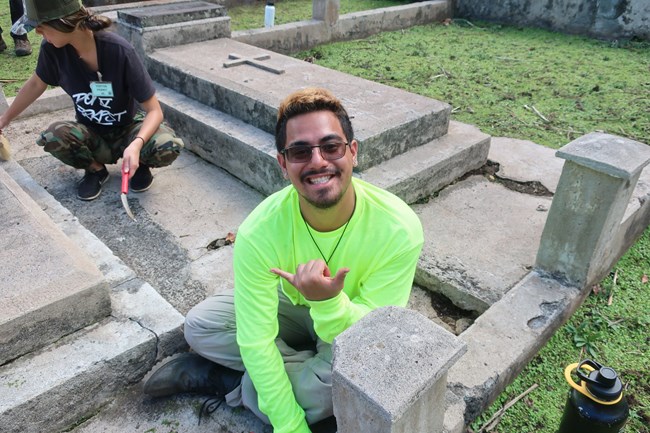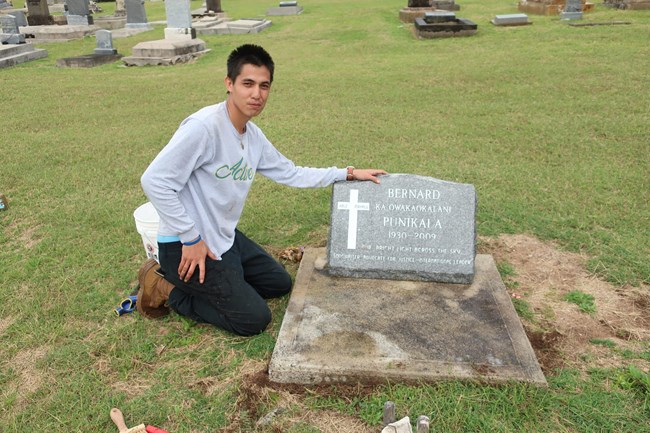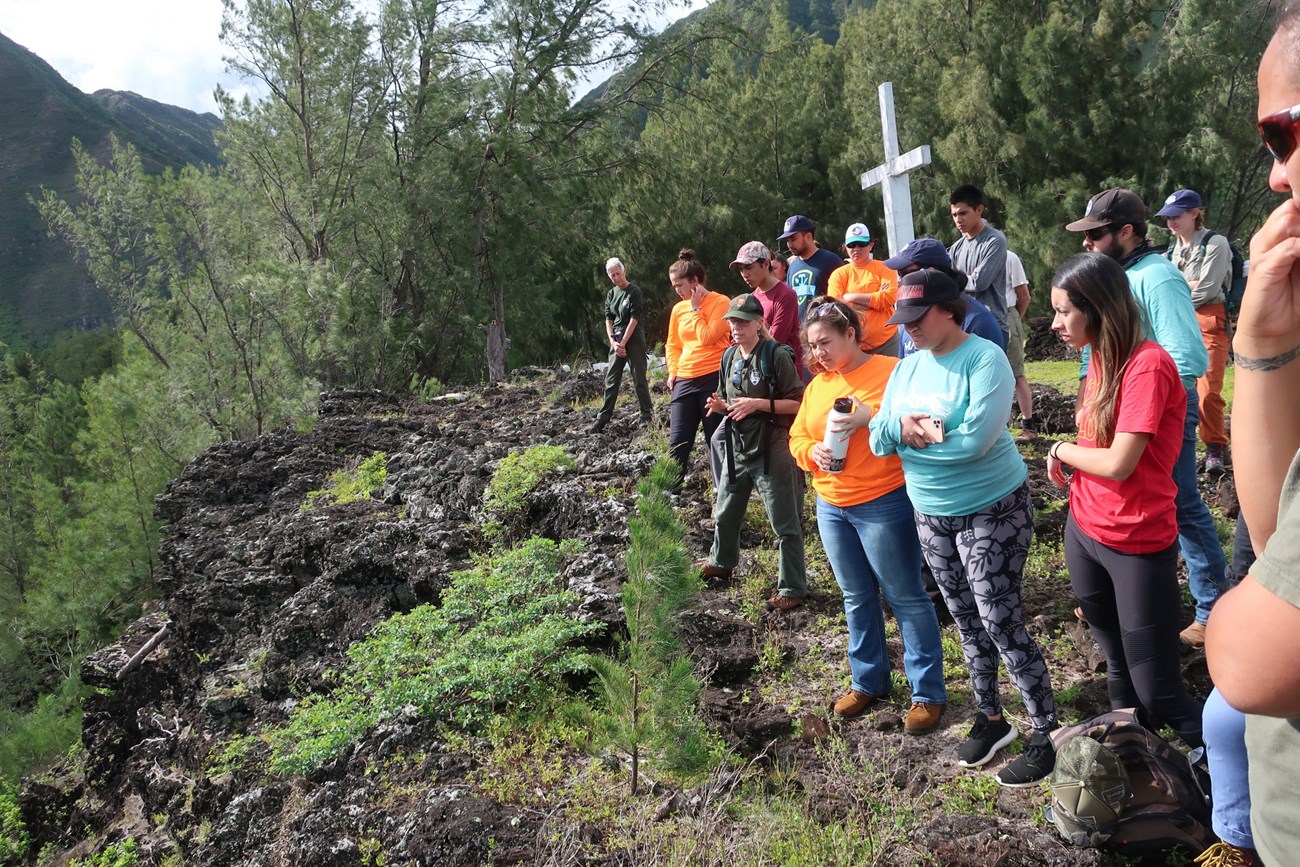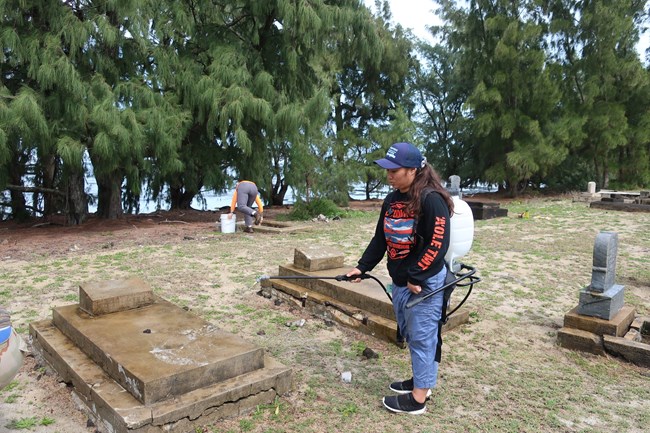Last updated: April 7, 2025
Article
Podcast 098: Hawaiian Studies at the University of Hawai’i Hilo

University of Hawaii Hilo
Hawaiian Studies Program
Student Group: Singing Hawaiian Song.
Jason Church: Introduce yourselves and tell me a little bit about the program.
Makoa: Aloha, mai kākou my name is Kekamamakoaaka’ilihou Kaleilani Caceres but I go by Makoa.
Emma: Aloha, ʻO wau ʻo Emma Kawaikahi Tanigawa, I just go by Emma.
CJ: Aloha, my name is Kenneth Clinton John Sweezey and I go by my middle initials, CJ.
Makoa: But to best explain Hawaiian studies, UH Hilo is really a place where the Hawaiian language is kind of revitalized, so a lot of our professors nowadays were the original folks who first made the first Hawaiian language text book. So, a lot of our focus is on revitalizing the Hawaiian language because it was almost a dead language at one point prior to the first Hawaiian renaissance in the 1970 -80s.
But we learn a bunch of different things involving language and culture. So, we have this thing called Kumu Honua Mauli Ola, which is the foundation of what a Hawaiian identity consists of. So, that includes language, spirituality, body language and all sorts of things. Throughout all of our courses at UH Hilo, base all of the coursework on those foundational beliefs.

Jason Church, National Park Service
What do you study?
Jason Church: So, what kind of things do you study in the program?
Emma: Besides language, we also study things such as traditional uses of native Hawaiian plants, we study traditional mele, traditional hula, we also have a papa iʻa class which is a class about ocean animals, fishing, stuff like that.
Makoa: There’s two pathways; so, there’s continuing the culture, which a lot of those courses focus on the revitalization of language and prepping you to become a teacher.
So, UH Hilo actually has the only teacher accreditation master’s course that’s completely done within Hawaiian language and that program is really meant to prepare some of our students to become teachers in the Hawaiian Immersion programs that the state provides. For those parents who put their children and want them to be educated primarily in the Hawaiian language.
And the other pathway, monitoring the culture, that’s kind of where they try to connect the Hawaiian studies program to all the other disciplines. So, some of the classes that count towards that degree our marine science programs, a lot of anthropology programs, history classes and that kind of stuff.

Jason Church, National Park Service
What drew you?
Jason Church: So, what drew you three to the Hawaiian studies?
Emma: Okay so, when I joined the Hawaiian studies program, my main goal for myself, was actually to learn as much traditional knowledge as I could in order to help educate others that do not have this same opportunity regardless of age, regardless of gender, regardless of race, because I feel like even in public schools all across Hawaiʻi, they don’t really have a good strong foundation when it comes to Hawaiian studies being implemented within public schools.
Developed, not only in schools but also in like all of Hawaiʻi and help it become our traditional knowledge, become more normalized.
CJ: I think that when I moved back home to Hilo, I went and lived with my grandfather, who I have never had a relationship with and he’s from Kalapana. Just learning from him, learning about that side of the family made me realize that I wanted to learn more about this place that I call my home or my second home.
Being back in school, especially in higher education in college has allowed me to really open many doors to learn about it.
Makoa: So the reason that I ended up joining the Hawaiian studies program, my parents met at UH Hilo and they were both in the Hawaiian studies program back in the late 90s.
When I was born, I was put into a Hawaiian Immersion preschool Aha Punana Leo o Kona and then as soon as I graduated from there, I went to kindergarten, from kindergarten through sixth grade, I was taught primarily in Hawaiian, in one of our Hawaiian Immersion schools, at Ke Kula Kaiapuni ʻo Waiau.
So, throughout my entire life, the Hawaiian language was all I knew and Hawaiian studies, wasn’t something that I needed to study to know, that was just my life was Hawaiian studies. Everything that I was taught from my parents, and everything at home is basically what I’m learning in class now. So, it makes it really easy for me.
The reason why I decided once I graduated high school, to jump back into it was because I felt my Hawaiian ideology that we have this thing called ʻO wau ma kuleana, which means to take care of your responsibilities. But to say that kuleana equals responsibility isn’t completely true. It’s more a part of who you are, it’s more a part of your identity, that you’re not your truest self unless you’re doing what you’re supposed to be doing for the betterment of your community.
And so, learning about my past, learning about my language, learning about my culture, it takes me one step closer to who my ancestors meant for me to be and that was a vital person within our world community.

Jason Church, National Park Service
I think that what we learn at UH Hilo, which is really unique compared to other universities, is that in order to make our world a better place, we need to take ourselves back into the mindset that those of indigenous culture had, that that’s the future that we want.
And that’s something that we’re learning here in Kalaupapa is that community and all of the foundational beliefs that are instilled within those communities, it is our duty, it is right to become those vital people in that community. And that’s what you learn at Ka Haka ʻUla or the Hawaiian studies program at UH Hilo.
Holding Piko
Jason Church: So, every morning here at Kalaupapa, you guys have done what’s called…what you call piko?
Makoa: First think of the word piko, it means center. So, like our human body we have three different piko’s and each piko connects us to a different part of who we are. So, at the top of our head there’s a piko and that connects us to our ancestors. Our bellybutton, that connects us to our mothers and our genitalia, that connects us to our future generations. So, piko, if all of your piko’s are in alignment, then that means that you’re in balance.
So, every morning we hold piko, because we’re trying to re-center ourselves, we’re trying to focus all of our energies so that we can ensure that whatever kuleana whatever responsibilities we have, that we are in a place where we can take care of those responsibilities.
Emma: With that being said, that’s why we choose certain mele to perform every day and along with that, we also have, well it’s tradition that the kāne [men] get their mana’o and that following that a wahine will come and give her mana’o based off of what the kāne had previously said and build off of that for the day.
CJ: Even when we say the E hō mai which is like asking for knowledge, right, I really like that because that’s what we’re trying to gain right now, we’re trying to gain knowledge from you Jason, you know from your preservation work, we’re trying to gain knowledge from the kūpuna here, like Mikiʻala and stuff and from our professor Kumu Kai and from one another. You know, we’re learning the weʻre feeding off of one another, so I really appreciate it and I wish more of my classes incorporated that type of protocol or that type of ritual…

Jason Church, National Park Service
Emma: I think growing up on Oahu, no one in my family spoke the language. No one in my family danced hula. No one in my family sang or knew any Hawaiian mele. I feel like after entering the Hawaiian studies program, I’ve learned so much about what it means to be Hawaiian, what it means to be Kānaka Maoli. I’m just very grateful for that.
Now, I’m teaching my family all these mele, I’m teaching my family hula, I’m teaching my family about all these traditions that they didn’t have the privilege to learn growing up. So, not only am I reconnecting to my ancestors but I’m helping all my family reconnect to my ancestors.
Makoa: So, I would say, kind of building off of what they’re saying, being a student at UH Hilo, not just in the Hawaiian studies program, but being a student at UH Hilo, just in general.
We’re in a very unique circumstance because there’s a lot going on in our communities, in our local communities makes our learning a little more important, makes our learning a little more interesting.
So, for example, Ka Haka ʻUla O Keʻelikōlani which is the name of the Hawaiian studies program at UH Hilo, came as a result of basically a bunch of our elders rebelling against the state and making their own illegal schools where they taught their children in Hawaiian. The Hawaiian studies program came as a result of those struggles.
Being a student at UH Hilo, which is located on the big island, during a huge controversy such as the thirty-meter telescope being built on Maunakea, it kind of teaches you that knowledge that you learn in the classroom is most important outside of it.
So, I feel like especially at Ka Haka ʻUla O Keʻelikōlani and especially being a political science major, learning all of these different strategies about how to advocate for indigenous rights, indigenous beliefs, indigenizing an educational system, that’s what makes being at UH Hilo awesome. Because we’re seeing the struggles that we’re learning about in classrooms happen live outside of our communities.
We can walk outside of our classroom, look up the road and see the mountain that, to us is sacred; a very large telescope is being proposed to be built up there and so I think that’s kind of the coolest thing that I’ve learned. I’m taking everything from one of my classes, bit by bit, and learning how to use that information to advocate on behalf of my people, our people, and I think that’s, yeah, that’s what makes me a UH Hilo student.
Student Group: Singing “Hawaiʻi Ponoʻī”
Read other Preservation Technology Podcast articles or learn more about the National Center for Preservation Technology and Training.
